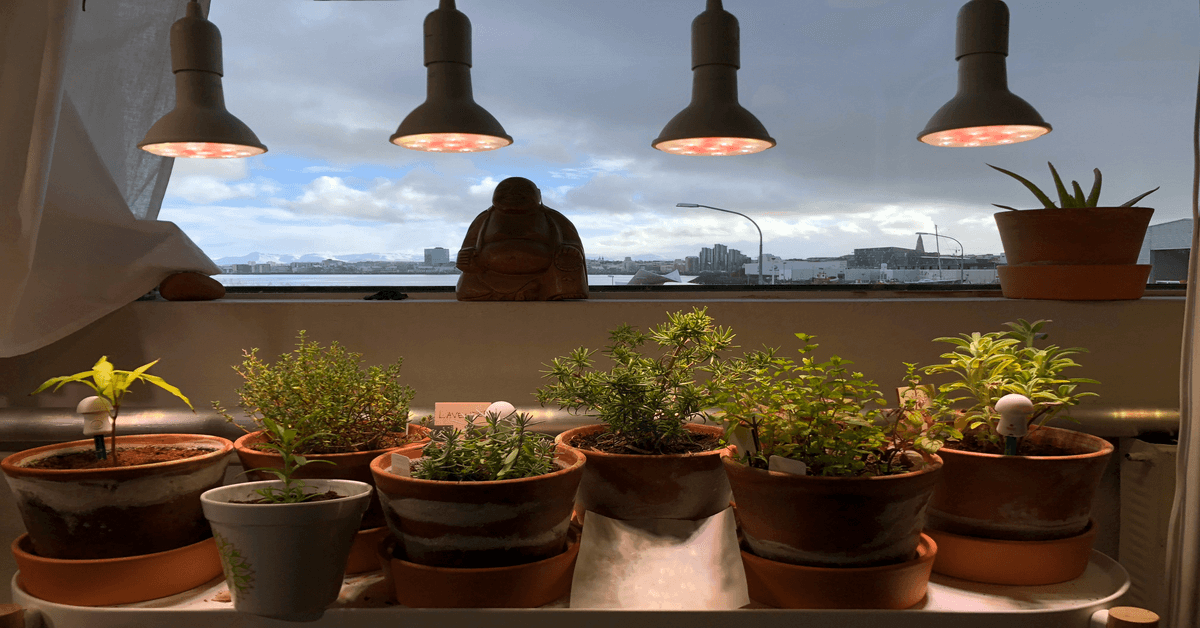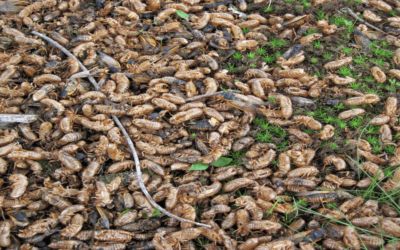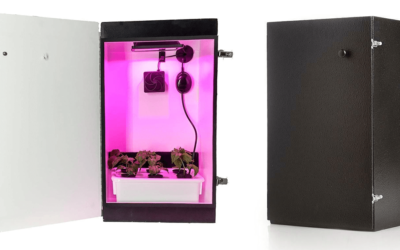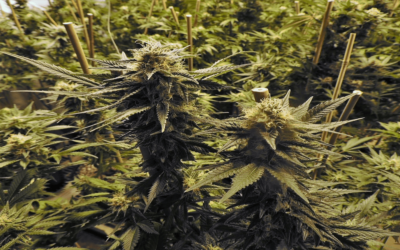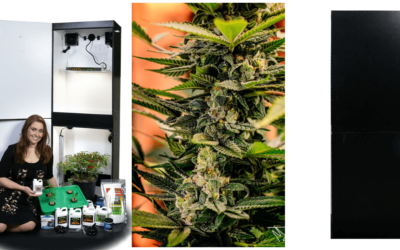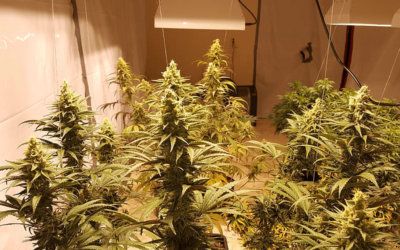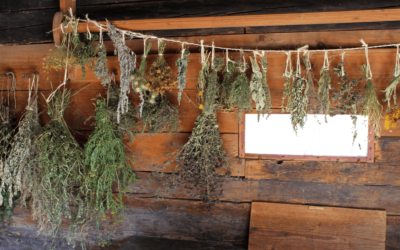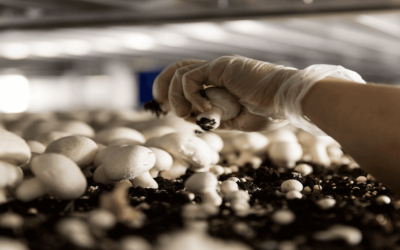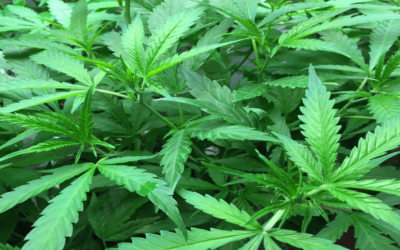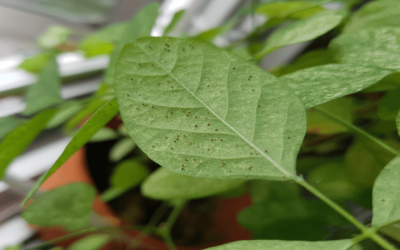You may grow several plants indoors with several grow lights, including house plants, orchidaceous plant, and even berry and herbal crops. Considering the energy efficiency and light spectrum, grow lights are perfect for beginning seeds since they guarantee stubborn, green roots. A winter crop may also be cultivated under appropriate light. Knowing how plants use light and the factors that decide the good quality of light for the plants, you may choose an indoor growing light system that suits your plants.
Reasons Standard Light Bulbs Not Good for Growing Plants
Why are grow lights best to opt for when growing your plants? Why not standard light bulbs. Let us know in depth.
1.The appropriate color
Sunlight includes the whole range of light, comprising of all rainbow colors: red, yellow, blue, and violet. Indoor plants are better cultivated under full-spectrum lamps while plants thrive outside in the sunshine and provide a cold and warm light combination that simulates the natural solar radiation. They are great for both seedlings and houseplants, food herbs, and other species.f Both our light fixtures stands and substitute bulbs are full-spectrum.
2.Time for plants to light
If you want to develop plants with a desk lamp, you must consider this lighting problem. You can’t just purchase a plant and adjust your bulbs and forget it.
Thinking of light also as a form of food for the plants is necessary, because it plays a significant role in the photosynthesis process. We consume oxygen, they photosynthesize – and light is used for plant growth. It is a brilliant idea to invest in a light monitor to be enabled and switched off on the correct schedule.
It may suggest that even though you don’t need the space you have light, don’t think about it too much. Desk lamps, in particular, LED lamps, consume very little electricity at all.
3.A spectrum of light and color temperature
Plants mostly use blue and red light to evolve, although research has shown that certain plants work better under the full range of sunlight.
Though natural light changes during the day at color temperatures, artificial light is static in color. If you want to encourage a particular development stage, a broad spectrum light with a specific color temperature should be chosen.
The basic rule is to choose a bright light with blue (5000-7000K) color temperature, promoting vegetative development. To encourage fruiting and blooming, determine red spectrum color temperature (3,500 – 4,500K).
Before contrasting grow lights to regular LED lights, we should first know what grow lights are. These lights emit specific colors that enhance the light emitted by the sun. They are primarily used for those who cultivate plants indoors. People sometimes ask whether they should replace grow lights with standard LED lights because plants can continue to photosynthesis in any case. Any considerations that can help you determine what performs well for developing plants’ continuous health and growth are mentioned below.
4.Emission of heat
It is a well-known reality that when electric energy is transformed into light energy, heat energy is emitted. This heat usually is not visible until you reach the lightbulb; but, to plants, such heat is not harmless. Regular lights typically emit a more significant percentage of heat than those specially intended to help plants grow. This heat can be harmful to plants. For example, the high heat produced will potentially burn leaves, not the desired outcome.
One disadvantage of utilizing standard bulbs for growing plants is their lack of performance. The volume of light used is small relative to the energy used to light the lamp. The point that is not used to light is discharged as heat. While the initial expenses may be minimal to buy light bulbs, they are far more expensive than fluorescent bulbs, and since led bulbs start to cost more.
5.Light spectrum
Light consists of different wavelengths that form the spectrum of light. Any light bulbs produce certain rays that do not have the same impact on plants as the sun does. In reality, indoor plants don’t grow because lack of light or sunshine can well imitate sunlight. The light spectrum of the grow lights is more suitable for plants to grow.
6.Energy efficiency
As discussed previously, standard lights are not good when it comes to price to performance. Unlike grow lights, they consume a significant amount of energy, which emit the requisite wavelengths without overheating. But on the other side, regular LEDs are more powerful, mainly if you buy energy-saving ones. This suggests that you must give priority to your grow lights.
Since too much energy is transferred into heat in lightbulbs, much of the light quality is lost. Because the bulbs are hot, they cannot be positioned near the plants, even though their light strength may be increased. Bulbs should not be put close to 24 inches from the plant to prevent plant damage. However, the loss of light power may be fixed by increased light exposure to the plant or by inserting reflecting surfaces to allow certain parts of the plant to meet the usable light.
7.Cost
Unlike grow lights, regular LEDs are very costly to maintain the best suitable living environments for indoor plants. This is since standard LEDs are more accessible and nearly everywhere can be readily purchased. Grow lights can be seen in different places but never in abundance, similar to LED lights.
Light bulbs are not particularly helpful for plants because they illuminate the spectrum’s red side, not on the blue side. They are often too hot for plants and can damage their development. They are often particularly ineffective, for one-third as fluorescent.
The fact that incandescent lights are extremely short-lived allows the usage more costly than other bulbs. Most lamps are just 750 to 1,000 hours long in comparison with led lighting, which will last almost 8,000 hours. It is only an average, and lifespan will vary wildly from only a few more hours to a few years. Whereas the initial expense is very cheap, considering the numbers of occasions these bulbs must be changed.
Typical fluorescent lighting performs much hotter and has a much broader range of illumination. While they generate light mainly from orange to blue, they don’t provide plants with enough lighting to do so much good if they are primarily built as grow lights.
In reality, grow lights are rising. They provide a higher volume of light and give the red end of the spectrum.
8.Narrow spectral wavelengths
The standard lights display different slopes created by light emission at those wavelengths in a continuous optical spectrum. These absorption lines are usually associated with electrical transformations, from lower to higher energy levels this time. If the lower stage is the soil’s electronic state, it is ground level absorption (GSA); (ESA).
Absorption lines have been detected and have led to the detection of helium since it was found on Earth. Absorption lines are also found in labs, e.g., with wide-band light sources and spectrographs or laser absorption spectroscopy scanning.
Even solid-state media such as laser crystals are similar absorption and emission lines. Here, the absorption and emission characteristics are also considerably wider because of the relationships between an organism’s absorption or emission and the host substrate.
Blue light (this is narrow in wavelength) typically suppresses the development of extension; blue light plants usually are shorter with thinner, thicker, and darker blue leaves than plants produced without blue light. These attributes may be desirable in ornamental development since blue light may essentially act as a growth regulator.
9.Usually does not support photosynthesis
The energy and knowledge required for growth should be provided to plants by artificial lighting. For this reason, flushing lamps are used widely in growth chambers, particularly with improved blue and red spectra (i.e., cool fluorescent white lamps), along with accompanying lights, for the long-term photosynthetic fluence needed for high productivity. However, fluorescent lights’ range and strength are no longer constant.
Often used in greenhouses and plant growing spaces, HID lamps like halide metal and high sodium pressure have comparatively high fluent (maximum 200 lumens/watt) and high performance (maximum 40 percent) of pHARS.
The drawbacks include a high fire arc demand, high operating temperature preventing the canopy position and the spectral spread. According to input capacity, these factors may vary, significantly restrict the green-yellow field’s usage and creativity ultraviolet radiation, and a red-modified ratio.
LEDs have the highest PAR performance of artificial lighting systems. LEDs of blue, green, yellow, orange, red color are usable, which, due to their light spectrum, can be coupled to provide either the strong fluence (with maximum sunlight when desired). The high performance, low operating temperature, and the smaller scale permit LEDs in pulsed illumination and intra-canopy radiation near the leaves.
Their long service life and control facility render them suitable for year-round greenhouses. It is anticipated that LED technologies would substitute fluorescent and HID lamps and revolutionize balanced growth conditions in horticultural systems.
10.Ineffective thermal control
LEDs are cold to the touch since, in general, infrared (IR) radiation does not contain warmth (unless, of course, they are IR LEDs).
IR radiation warms inflammatory lamps and other objects in their enclosures and surroundings. LED fittings are located in places where heating from traditional sources could create a specific issue, e.g., illuminating food or textiles given the absence of IR radiation.
But the inefficiency of the semiconductor processes that generate light is crucially essential to heat inside the LED system itself. The wall plug performance of LED packages (optical power separated by electric power) usually is 5-40%, which means that 60-95% of the input energy is wasted as heat.
A 100w GLS incandescent bulb consumes approximately 12% heat, 83% IR, and only 5% visible light. On the other hand, a standard LED may generate 15% visible light and 85% heat.
This heat must be removed employing efficient thermal control, particularly with high-speed LEDs. The LED’s inner temperature (joint) can increase without a good heat sink, which results in a shift in the LED features.
As LEDs raise their connecting temperature, both the forward and lumen voltages are reduced. For a difference in the junction temperature, the output wavelength often changes.
Best Grow Lights That You Can Choose
The LED grow lights are the most reliable, robust, and customer-friendly to develop plants at home, owing to their low energy use and low temperature than the standard or incandescent lights. The brightness of the lamp and the closeness to the light source determines the light strength received by a plant. The intensity of light is different for the plants. Plants found in dense tropical forests or gloomy forests usually need less light than plants that have developed in sunny and dry climates.
Any floral housing plants can be 10 to 12 centimeters removed from a light source, including African violets and begonia. Feeders like ivy or philodendron may be mounted up to 36 centimeters from a light source. However, many flowering plants, including orchids, gardenias, and citrus, and most vegetable plants need even more extraordinary flowering and fruit-making light intensity.
Conclusion
Like house plantations, Orchids, and even certain fruits and plants, many trees can be grown indoors with a series of grow lights. Grow lights are perfect for beginning seeds since they will guarantee stubborn, green plantings. You should cultivate the winter crops such as herbs and salads in significant amount of light as well. You will choose an indoor growing system that is ideal for plants you want to develop by studying how plants use energy and the fittings choices.
Growing lights for house plants enable you to grow an extensive range of plants at every time of year in any environment. These grow lights are specifically built to replace the natural sunshine, stimulate photosynthetic activity, and provide the right color. The high thermal efficiency and raising energy efficiency combine to deliver an optimal selection for the light spectrum. We invite you to read our post about the differences between CMH vs. LED grow lights and which one suit your growing needs.
Therefore, standard lights are not what you are looking for, and grow lights are the best to choose when it comes to growing plants!

